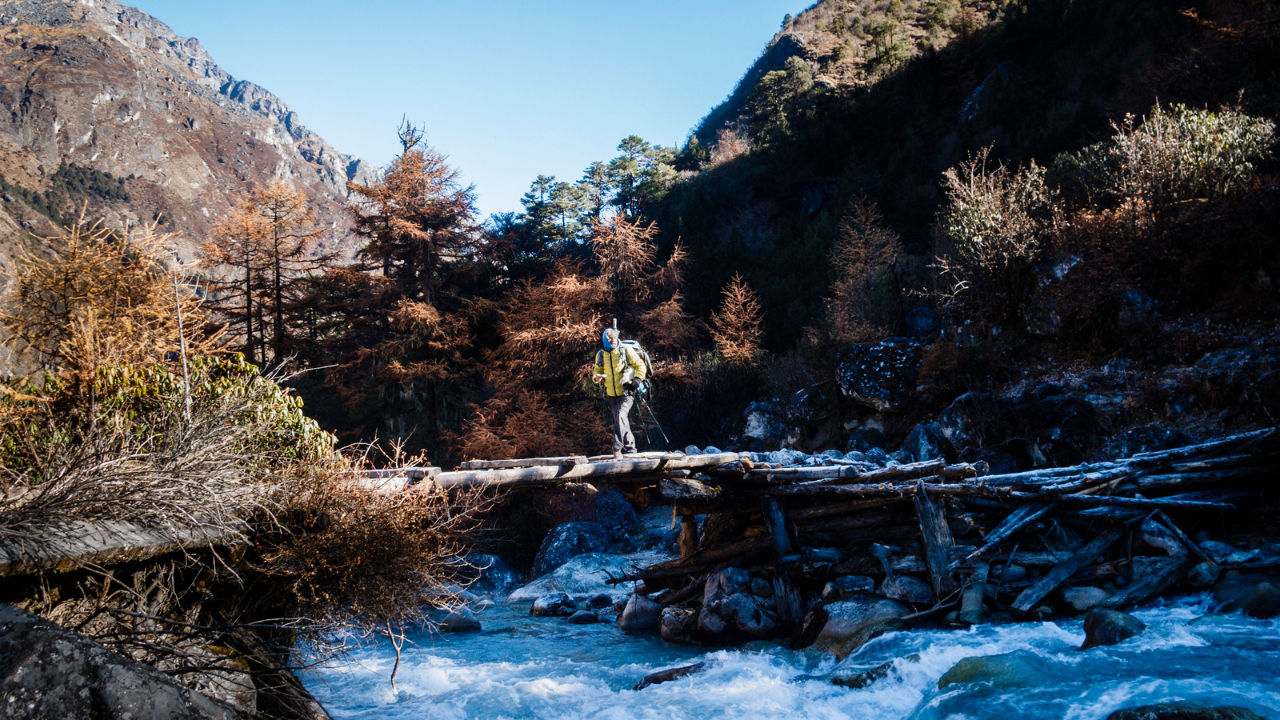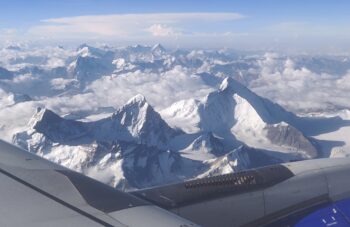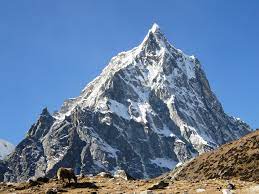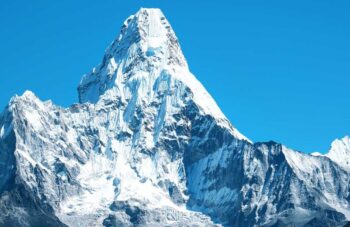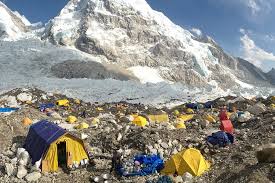Kanchenjunga Base Camp Trek
Overview
The Kanchenjunga Base Camp Trek is a breathtaking journey through the remote and pristine landscapes of the eastern Himalayas, offering trekkers an unparalleled adventure into the heart of nature. Located in eastern Nepal, Kanchenjunga is also the third highest mountain in the world and the main attraction of this trek.
The journey begins with a scenic flight from Kathmandu to Taplejung, a small town in the eastern hills. From there, the trek commences, taking trekkers through charming villages, lush rhododendron and bamboo forests, and terraced farmlands. The region is also inhabited by diverse ethnic groups like Sherpas, Limbus, and Rais, allowing trekkers to experience local culture and traditions.
As the trail ascends, the majestic peaks of Kanchenjunga and its neighboring summits come into view, providing awe-inspiring panoramas. Trekkers pass through quaint settlements like Ghunsa and Khambachen, where yak herders and friendly locals offer warm hospitality. The enchanting landscapes feature glacial valleys, cascading waterfalls, and mesmerizing alpine lakes, such as the sacred Sele La and Pang Pema.
Kanchenjunga Base Camp Trek: A Biodiversity Paradise for Adventurers
The Kanchenjunga Conservation Area is rich in biodiversity and also provides an opportunity to spot a variety of wildlife, including the elusive snow leopard, red panda, and many bird species. The trek’s remote and unspoiled nature makes it a perfect destination for nature enthusiasts and adventurous souls seeking tranquility.
The trail also leads to the Kanchenjunga Base Camp, where trekkers can relish an up-close view of the towering peaks and immerse themselves in the grandeur of the Himalayas. The sight of the sunrise casting its golden rays on the snow-clad summits is an unforgettable moment.
Due to its challenging terrain and restricted access, the Kanchenjunga Trek is less crowded than other popular treks in Nepal, adding to its allure for those seeking a more off-the-beaten-path experience. Proper physical fitness and acclimatization are essential to undertake this trek successfully.
Conclusion and Summary
In conclusion, the Kanchenjunga Base Camp Trek is a mesmerizing odyssey that blends natural beauty, cultural richness, and adventure. It is an opportunity to connect with the pristine wilderness and immerse oneself in the splendor of the world’s third-highest mountain, leaving trekkers with unforgettable memories of a lifetime.
Itinerary
-
Day 01: Arrival in Kathmandu (1,300m /4,264 ft)
Upon arrival in Kathmandu airport you will be expected to complete your custom formalities (visa etc). We suggest you to look for our representative who will be waiting for you at the arrival gate with a Everest Expeditions Nepal display board. You will then be transferred to your hotel. After checking in you can either take rest, or visit our office. In the evening, there will be a welcome dinner hosted by Everest Expeditions Nepal where you will be served excellent Nepalese cuisine which will introduce you to the country’s food culture.
-
Day 02: Sightseeing in Kathmandu and preparation for trekking
Completion of required official procedures and taking a cultural tour of Kathmandu before the actual trekking will be the main agenda of this day. After breakfast there will be cultural tour to world heritage sites in Kathmandu which includes Kathmandu Durbar Square, Pashupatinath Temple, Swayambhunath, and Bauddhanath. During the afternoon, you will be meeting with other participants of the trekking program along with your guides at EEN office or Hotel Meeting Hall for a pre-trip discussion.
-
Day 03: Fly from Kathmandu to Biratnagar (81 m/266 ft)
You will fly from Kathmandu to Biratnagar. Depending upon the availability of flying options to Suketar from Biratnagar you will be presented with either of the two possibilities listed below:
- If there is availability of flight to Suketar you spend the night in Biratnagar and fly to Suketar the next morning.
If there are no flights available to Suketar you drive to Phidim and spend the night there
-
Day 04: Fly from Biratnagar to Suketar (2,420 m/7,938 ft) or Drive from Phidim (1,179 m/ (3,868 ft) to Suketar
If you spent overnight at Biratnagar the previous day you will directly fly to Suketar this day and spend the night there. But, if you spent your night in Phidim you will be driving to Suketar. Either way you spend overnight at Suketar.
-
Day 05: Suketar to Mitlung (921 m/3,021 ft) 4-5 hrs
We officially kick start the day with a downhill walk to Mitlung. The trails throughout the lower sections of the Kanchenjunga region pass through fertile valleys with beautiful pastures and small villages. We then cross Hangdewa River and walk alongside the raging Tamor River. As we gradually head in a northerly direction the trail steepens after a few hours before a final descent of 350 meters on a muddy trail to Mitlung. We spend the night there.
-
Day 06:: Mitlung to Chirwa (1,270 m/4166 ft) 5-6 hrs
The trail ascends and descends steadily as we make our way towards the village of Sinwa. We continue trekking downhill until we reach Tawa. At Tawa, we ascend to some heights and cross the suspension bridge at Thiwa. We pass beautiful rural landscape along the way and reach Chirwa, a beautiful Limbu village with few lodges, tea shops etc. We spend the night at Chirwa.
-
Day 07: Chirwa to Sukathum (1,576 m/5,169 ft) 5-6 hrs
The trek from Chirwa to Sukathum passes through varied landscapes such as cardamom fields and dense forests. We trek uphill for sometime then descend to the lush green fields below and continue trekking along the Tamor River passing through a dense forest. It’s both uphill and downhill trek until crossing the Ghunsa River after which we reach Sukathum and spend the night there.
-
Day 08: Sukathum to Amjilosa (2,308 m /7,570 ft) 6-7 hrs
Trekking from Sukathum to Amjilosa is challenging. After crossing the suspension bridge outside Sukathum we enter a dense forest, ascend the steep trail, descend and cross the river again. We also climb a gorge from the bottom and pass by Solima village and descend again to the level of the river. All in all, this day’s trekking is rather tough. Therefore, it is advisable to be very careful especially while walking the trail that passes the gorge. We later follow a tricky trail which goes both uphill and downhill until reaching Amjilosa where we spend the night.
-
Day 09: Amjilosa to Gyabla (2,730 m /8,954 ft) 6-7 hrs
We start trekking from the river bank, pass through a densely forest of bamboo, fir and rhododendrons eventually reaching a small stone house by the river. We then climb uphill crossing a few small bridges along the way. Here, we get to enjoy the company of stunning waterfalls that originate from the mountains. After yet another short uphill walk we reach the Tibetan settlement to Gyabla.
-
Day 10: Gyabla to Ghunsa (3,595 m/11,792 ft) 5-6 hrs
We descend down the river and notice the valley as it slowly opens up before reaching Phale, a Tibetan refugee settlement where it is possible to purchase handicrafts and homemade rugs from locals. After purchasing a few souvenirs we travel through conifer and pine forest and reach the Sherpa village of Ghunsa where we spend the night. This place is known for its hydroelectricity plant and the fact that more than 20 prominent conservationists met a tragic end in a helicopter crash.
-
Day 11: Acclimatisation day at Ghunsa
We take care to spend time acclimatising around Ghunsa before continuing our next day’s trek. We recommend you to stay active even in a rest day as it is better than being idle while on a trekking journey. Therefore, we take a short hike towards the Laspsan La monastery through the lush green forest. Come back to Ghunsa by afternoon and relax.
-
Day 12: Ghunsa to Kambachen (4,050 m/13,284 ft) 5-6 hrs
From Ghunsa we trek further north along the river bank which presents us with magnificent mountain scenery. We pass through meadows full with beautiful wildflowers, rhododendron and pine forests. We cross a bridge at Rampuk Kharka, continue past the waterfall and cross the tricky section of the landslide. After crossing the landslide area we begin to see the spectacular view of Mt. Jannu. Further exploring and tackling the tricky mountain trail we finally arrive at Kambachen and spend the night.
-
Day 13: Acclimatisation Day at Kambachen
We take yet another day for acclimatisation at Kambachen which is reserved to accommodate participants in high altitude and also to observe if anybody in the group has any symptoms of altitude sickness. The overall idea for this day is to relax- take a bath and/or explore the Nuphchu Khola Valley area. We spend yet another night at Kambachen.
-
Day 14: Kambachen to Lhonak (4,780 m/15,678 ft) 6-7 hrs
Today will be another challenging day and an early start is needed. We trek through rocky fields and large boulders on the hillside along the riverbank and arrive at a waterfall. We then cross a bridge to Ramtang monastery. We then come across a landslide section which we must pass through at a steady pace before descending to the river and finally arriving at Lhonak.
-
Day 15: Trek to Pangpema/Kanchenjunga North Base Camp (5,388 m/17,673 ft) 6-7 hrs
We trek along the Kanchenjunga Glacier to spend a night at Pangpema, Kanchenjunga base camp on the north side. We urge you to be careful around the rockier sections as they are prone to landslides. After a short while you reach Pangpema, a flat grassy base camp. Climb a little higher and enjoy the splendor of Jannu, Kanchenjunga and Chang Himal.
-
Day 16: Trek back to Kambachen (4,050 m/13,284 ft) 6-7 hrs
We retrace our path to Lhonak and continue down the valley to Ramtang Monastery. The return journey offers a different perspective of the mountains Kanchenjunga, Taple Shikhar, Gimmigela, and Mera Peak among others. Due to the descending nature of this trek we will reach Kambachen by evening and spend the night there.
-
Day 17: Kambachen to Ghunsa (3,595 m/11,792 ft) 3-4 hrs
It’s essentially the reverse of our Day 12 trek. We descend to Ghunsa from Kambachen which means that we get to enjoy the beautiful forests along with a backdrop of impressive mountain scenery. Overnight at Ghunsa
-
Day 18: Ghunsa to Sele Le (4,290 m/14,071 ft) 6-7 hrs
It’s a steep trek upward from Ghunsa to Sele-Le. Upon reaching Sele Le we climb through a dense forest of moss, rhododendron and juniper. Lunch will be served in an appropriate place with the availability of water. We spend the night in Sele Le.
-
Day 19: Sele Le to Cheram (3,870 m/12,694 ft) 6-7 hrs
We do an uphill trek and enjoy the mesmerizing south side view of Jannu Himal and Makalu (the world’s 6th highest mountain). Today is a strenuous trekking day as we cross several passes- Sinion La, Mirgin La and Sinelapche Bhanjyang. We then make a steep descend to Cheram and spend the night there.
-
Day 20: Cheram to Ramche (4,580 m/15,022 ft) and return back to Cheram, 4-5 hrs
We ascend past the snout of the Yalung Glacier and walk alongside the Simbuwa Khola, pass through Lapsang village and reach Ramche. While there, we walk further up the valley or ascend a ridge for a tremendous view of blue sheeps. We then follow the stream before climbing on the moraine top until confronted by Kanchenjunga’s southern face. We walk further ahead for a glimpse of the Jannu Himal. We can even consider continuing to Oktang Monastery. Descend and spend the night at Cheram.
-
Day 21: Cheram to Tortong (2,995 m/9,824 ft) 5-6 hrs
As we descend to Tortong we first encounter two trails. One trail is the one we took while descending down from Sele Le. However, we ignore this route and descend further down to the trail alongside the Simbuwa Khola. We enjoy the lush rhododendron forest along the way.
-
Day 22: Tortong to Yamphudin (2,080 m/6,822 ft) 6-7 hrs
While descending from Tortong to Yamphudin we pass through Lasiya Bhanjyang which involves walking up through trees and area of landslides. The terrain changes after every monsoon but by the middle of October it should be stable with a route through. Walking further down we reach the village of Yamphudin, a village inhabited by Sherpas, Limbus and Rais.
-
Day 23: Yamphudin to Yangpang (1,007 m/3,304 ft) 6-7 hrs
We descend from Yamphudin, cross the bridge at Samekham and continue following the Kabeli Khola. We pass through Mamankhe which houses the Limbu Museum and Cultural Center. We then cross the bridge over Khaksewa Khola and ascend through the cardamom forest, pass by a few villages and descend further down to Yangpang. Overnight at Yangpang.
-
Day 24: Yangpang to Thorpu (1,500 m/4,290 ft) 5-6 hrs
Instead of going back to Taplejung we descend down to Thorpu. By opting for Thorpu we will not only be saving us time but will also get to enjoy the landscape of a different route. While descending to Thorpu we pass through some really beautiful terraced villages, where the people are very interested to see you. We spend the night in Thorpu and enjoy the hospitality of the villagers.
-
Day 25: Thorpu to Birtamod (300 m/ 984 ft) 5-6 hrs
We are most likely to drive from Thorpu to Birtamod which is a lively Terai town in Eastern Nepal. Along the way you will notice the climate getting warmer with a landscape that is different from the mountains and the hills. The town boasts a number of good accommodation facilities therefore we spend the night in Birtamod.
-
Day 26: Drive from Birtamod to Bhadrapur then Fly to Kathmandu
The drive to Bhadrapur from Birtamod is only of short distance. We fly back to Kathmandu from Bhadrapur Airport. Upon arriving in Kathmandu you can take a rest and relax throughout the day in your hotel or if you are interested in taking souvenirs for your loved ones, you can shop around the tourist area of Thamel. To celebrate the successful completion of our journey, we will have a farewell dinner in the evening. Overnight in Kathmandu.
-
Day 27: Farewell !
Your journey comes to an end today. There is nothing to do but trade emails with your travel companions and organize your photos. A representative of Everest Expeditions Nepal will take you to the airport approximately 3 hours from your scheduled flight. On your way home you will have plenty of time to plan your next adventure in the wonderful country of Nepal.
Include / Exclude
Cost Includes:
-
- Airport Pick-up and Drop Off,
- Licensed and trained trekking guides,
- potters for carrying goods and supplies,
- Meal on full board (breakfast, lunch, dinner) basis during the trek
- 3 Nights Accommodation in the 3 Star Hotel in Kathmandu with B & B. (Bed & Breakfast) on Twin Sharing Basis.
- All accommodation on Tent during the trek on sharing Basis.
- All meals and hot beverages during the trek.
- Transportation to and from trail head by Private and Sharing Transport
- All necessary documents and permits for trekking (where applicable)
- National Park/Conservation Area entry Permit, Insurance, and
equipment for the staffs. - Coordination of quick Rescue service (Costs covered by your Insurance Plan)
- Trekking staffs wages etc.
- Welcome dinner in a Nepali Cultural Dance restaurant in Kathmandu.
- Trekking Map, T-shirt, and Trekking certificate.
- Exclusive of Medical Kit Bag
- All Government and local Taxes
- International Flight ticket re-confirmation.
- Meals will be Start when your Trek starts.
- Domestic Flights
- Domestic Flights for Trekking Guide.
- Trekking Staff Insurance of $10,000 Per Person.
Cost Excludes:
- International Airfares,
- Travel/Trekking Insurance,
- Excess baggage charges More than 16kg and hand bag more than 5 kg in domestic flights.
- Visa fees.
- Airport Departure Taxes.
- Drinks (Cold and Alcoholic) Rescue charge.
- Tips for The staffs.
- Expenses of Personnel nature and Permit and Liaison officer fee (where Applicable.
- Meals during stay in the Kathmandu
- Extra Domestic Ticket of Jomsom, Pokhara etc.
- Extra Hotel in Kathmandu and Pokhara
Price per person
Usefull Information
Reaching the Kanchenjunga Base Camp is a true achievement. The base camp offers awe-inspiring views of the snow-clad peaks, including Kanchenjunga and its surrounding majestic summits. The sight of these towering mountains against the clear blue sky is a sight you’ll never forget.
The Kanchenjunga Base Camp Trek is a strenuous trek that requires good physical fitness and stamina. The altitude can be challenging, so acclimatization days are essential to ensure a safe and enjoyable journey. The best time to undertake this trek is during the spring (March to May) and autumn (September to November) seasons when the weather is relatively stable, and the views are spectacular.
Overall, the Kanchenjunga Base Camp Trek is an unforgettable adventure that combines breathtaking natural beauty, cultural exploration, and a sense of achievement. It offers a chance to disconnect from the modern world and immerse yourself in the raw and untouched wilderness of the eastern Himalayas.
Equipment List
-
 Best Seasons March to May, September to November
Best Seasons March to May, September to November -
 Group Size 2-20
Group Size 2-20 -
 Duration 26 DAYS BOOKING OPEN
Duration 26 DAYS BOOKING OPEN -
 Trek Difficulty Challenging
Trek Difficulty Challenging

